Have you ever wondered what the difference between flat iron steak and flank steak is?
Do you often find yourself in the meat aisle of your local grocery store baffled by all the choices for beef cuts? If so, then don’t worry – you’re not alone.
It can be confusing to discern which type of steak will best fit your needs when shopping for beef at a store or restaurant.
In this blog post, I will share with you some key differences between flat iron and flank steaks that should help simplify your next purchase decision.
Read on to discover why these two steaks differ in flavor, texture, cost, cooking methods and more.

What is Flat Iron Steak?
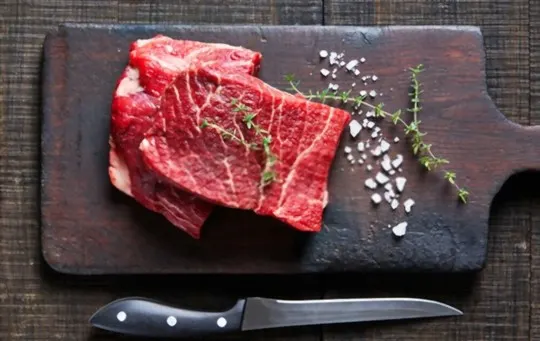
Flat Iron steak is a lesser-known cut of beef that has gained increasing popularity in recent years.
This cut comes from the shoulder blade area of the cow and is a relatively thin piece of meat with a characteristic long and rectangular shape.
It is a marbled cut of beef, meaning it has pockets of fat throughout, creating a tender and juicy texture when cooked to perfection.
The reason for its popularity is due to its affordability, flavor, and versatility in the kitchen.
Despite being relatively unknown, Flat Iron steak is a tremendously flavorful cut that deserves more recognition, and once you try it, it will surely become a go-to for your beef cravings.
In this article, we will dive into the in-depth details of this delicious cut of beef, from the cooking techniques to the best way to serve it, so that you can enjoy it to the fullest.
What is Flank Steak?
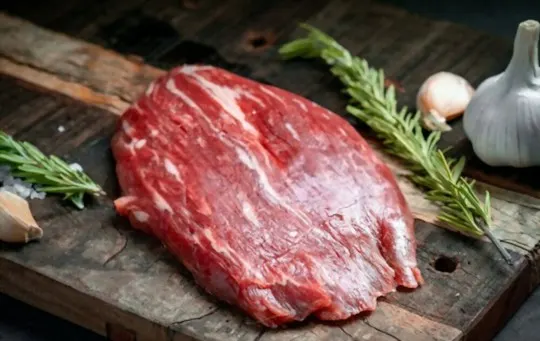
Flank steak, a cut from the abdominal muscles of beef, is a popular choice for grilling and cooking in a variety of dishes.
It boasts a deep, meaty flavor that pairs well with a wide range of seasonings and marinades.
This lean, long cut is known for its distinct texture and is perfect for dishes such as fajitas, stir-fries, or even on its own.
Despite its popularity, many people are unaware of the diverse ways they can incorporate flank steak into their cooking repertoire.
With its versatility, this cut is a must-try for any meat-lover looking to experiment in the kitchen.
In the following paragraphs, we’ll dive deeper into the in-depth details of this captivating cut of meat.
Differences Between Flat Iron and Flank Steak
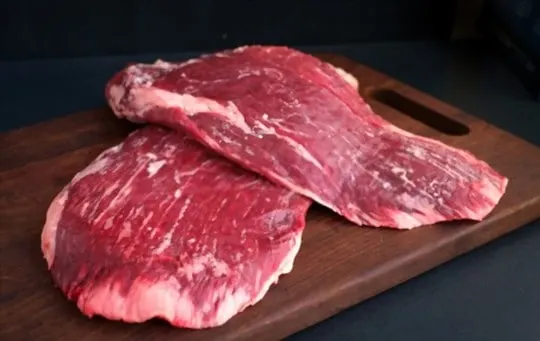
Flat iron and flank steak are both popular cuts of beef, but they have different characteristics that distinguish them from each other.
While both cuts are delicious in their own way, choosing one over the other depends on personal preference and the specific dish being prepared.
Location and Cut of Meat
Locating the right cut of meat is essential for a perfect meal.
The cut and location of meat play a vital role in determining the taste, texture, and tenderness of the dish.
Here, we will compare the flat iron and flank steak to help you make an informed decision.
Flat iron steak comes from the shoulder region and is a relatively newer cut compared to other traditional cuts.
On the other hand, flank steak originates from the abdominal muscles of the cow.
These cuts are unique in their way, providing distinctive texture and flavors to your meals.
When it comes to cooking methods, both these cuts require high heat cooking techniques for tender and juicy results.
It’s worth noting that there are some differences in fat marbling between flat iron vs flank steak.
Flat iron has more marbling than flank steak which means that it can be cooked to a higher degree of doneness without sacrificing flavor or tenderness.
However, flat iron is smaller in size than a typical flank steak which makes it easier to cook faster.
Texture and Tenderness
When it comes to the quality of meat, its texture and tenderness play a vital role in its overall taste.
The difference in how flat iron and flank steak cuts are prepared affects their texture and tenderization.
While both are good options, flat iron steak is considered more tender due to its uniform thickness compared to flank steak’s coarse and uneven texture.
This influences the ability of marinades to penetrate deeper for better tenderization.
Furthermore, Flat iron steak is often preferred for grilling or pan-searing because of its even thickness, which allows for consistent cooking results.
In contrast, flank steak requires a longer marinating process for better flavor penetration and is best cooked quickly over high heat and sliced against the grain for maximum tenderness.
Ultimately, choosing between flat iron vs flank steak comes down to personal preference based on desired texture, cooking method, and flavor profile.
Regardless of your choice, make sure you prepare the cut correctly as per your chosen recipe to fully experience the delectable flavors these steaks have to offer.
Flavor and Taste
The two cuts of beef, Flat Iron and Flank Steak, have distinct flavor and tastes that make them popular among steak lovers.
While both cuts share a similar meaty richness, the Flat Iron boasts a softer texture and richer beefy flavor that is likened to ribeye.
On the other hand, the Flank Steak has a bold and robust taste with its grainy texture that is often used in tacos or stir-fried dishes.
Ultimately, the choice between these two delectable cuts will depend on one’s personal preference for texture and flavor profile.
Cooking Methods
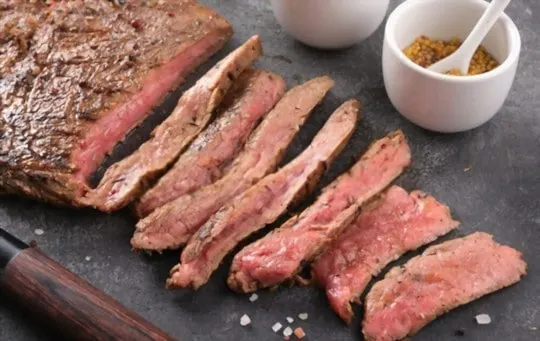
When it comes to preparing meat, choosing the right cooking method is crucial.
Different cooking methods can lead to a variety of results in terms of flavor, texture, and overall presentation.
One of the most important considerations when deciding on a cooking method is the cut of meat being cooked.
For instance, flat iron and flank steak are two popular cuts of beef that are often compared due to their similarities.
However, they require different cooking methods to be prepared properly.
Both cuts have distinct textures and flavors that can be enhanced or altered by the way they are cooked.
While flat iron steak is best suited for dry-heat cooking methods such as grilling or broiling, flank steak performs better with moist-heat techniques like braising or roasting.
The main difference between these cooking methods is how they affect the meat’s internal temperature and moisture content.
Overall, both flat iron and flank steak are delicious options for any meal but selecting the right cut depends on factors such as personal preference, recipe requirements, and desired result.
Understanding how to properly cook each cut ensures a satisfying and flavorful outcome every time.
Price
When it comes to purchasing meat, the cost is always a factor to consider.
The price difference between Flat Iron and Flank Steak can vary depending on several factors such as location, seasonality, demand and supply.
- Flat Iron steak typically costs more per pound than Flank Steak because of its superior taste and texture.
- Flank Steak is usually less expensive as it requires more tenderizing methods due to its toughness.
- The price point for both meats can fluctuate frequently, so paying attention to sales or shopping in bulk can save you money.
- If cost is a major factor, it may be beneficial to opt for Flank Steak over Flat Iron steak.
It’s important to note that price isn’t the only factor to consider when choosing between Flat Iron and Flank Steak.
Other factors like cooking methods, flavor preferences and texture should also be considered before making a purchase decision.
Similarities Between Flat Iron and Flank Steak
Flat iron and flank steak have several similarities, making them ideal options for grilling, broiling or pan-searing.
Both cuts are lean and flavorful, with a slightly chewy texture.
They come from the shoulder and abdominal muscles of the cow respectively and require careful attention to seasoning and cooking temperature to ensure they remain juicy.
Another common feature is their versatility in recipes – they work well in fajitas, stir-fries, sandwiches, or as the main entree.
Besides being a great source of protein, these steaks are rich in iron and other nutrients essential for a healthy diet.
Nutritional Value Comparison
Comparing the Nutritional Values of Flat Iron Steak and Flank Steak is essential to determine which one is a healthier choice.
Flat Iron steak has more protein, iron and vitamin B12, whereas flank steak is higher in vitamin B6 and zinc.
It is important to note that both cuts are lean options when trimmed properly.
To make an informed decision, one must consider their dietary requirements and health goals before choosing between the two cuts.
The differences in nutritional value don’t stop there, as each cut also has unique characteristics.
For example, flat iron steak contains more marbling than flank steak, which contributes to its tenderness.
In contrast, flank steak is a thin cut of meat with long muscle fibers that require marinating or slow cooking to achieve optimal tenderness.
It’s important to note that beyond their nutritional content and unique characteristics, both cuts offer versatility in cooking methods and flavor profiles for various recipes.
Understanding the differences between these cuts can help individuals make informed choices about their dietary needs while also exploring new flavors in their meals.
Which One is a Better Option?
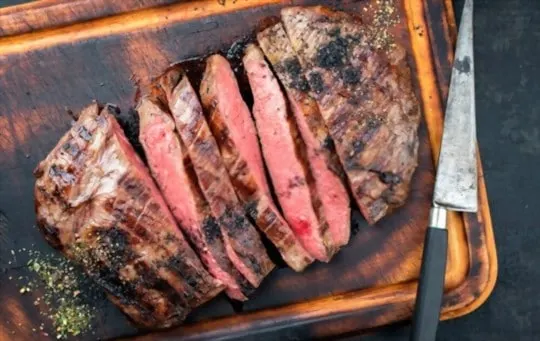
Comparing the two popular types of beef, there are several factors to consider before deciding which one is a better option.
When it comes to flat iron vs flank steak, both have their own unique attributes that make them suitable for different cooking methods and recipes.
Flat iron steak is known for its tenderness and rich flavor.
It is cut from the shoulder area of the cow and has a thick marbling of fat that adds to its juicy texture.
On the other hand, flank steak is leaner and tougher in texture, but with proper marination and grilling techniques, it can be cooked into a flavorful dish.
In terms of price, flat iron steak tends to be more expensive than flank steak due to its higher quality and demand in the market.
However, both steaks can be equally delicious when prepared with care.
Ultimately, choosing between flat iron and flank steak comes down to personal preference and the recipe you plan on using.
Flat iron may be a better option for those seeking a tender cut with bold flavor, while flank steak may be preferred by those looking for a leaner protein source that can still pack a punch in terms of taste.
Where to Buy Flat Iron and Flank Steak
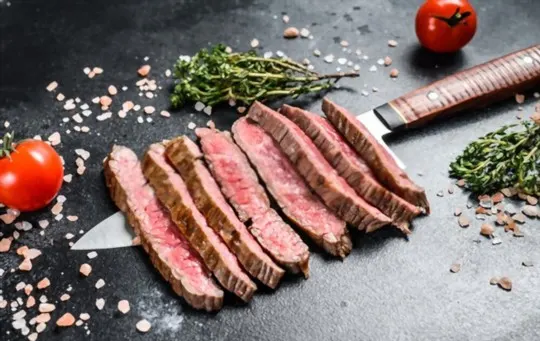
When it comes to buying flat iron and flank steak, there are various options available both online and offline.
You can consider purchasing it from your local grocery stores, butcher shops, or online meat retailers.
However, the availability may vary based on your location and the season.
If you prefer to buy meat from physical grocery stores or butcher shops, then you may have a chance to inspect the quality of meat before purchasing it.
Moreover, some popular grocery stores like Walmart and Costco offer flat iron and flank steak at an affordable price.
However, if you want a more convenient option, then buying online could be the best choice for you.
Online meat retailers like Omaha Steaks, ButcherBox, and Snake River Farms offer premium-quality flat iron and flank steak with doorstep delivery.
Additionally, they provide detailed information about the source of meat such as grass-fed or grain-fed and how it is cut.
Some even offer monthly subscriptions that allow you to save money while getting regular deliveries of fresh meats.
Lastly, some restaurants also sell raw meats including flat iron and flank steak through their websites or online marketplaces like Amazon Fresh or Instacart.
However, the prices may vary depending on the restaurant’s reputation and location.
Overall, buying flat iron and flank steak is easy today due to numerous options available both in-store and online.
Consider your preferred method of shopping along with quality concerns while selecting the best option for yourself without burning a hole in your pocket.
Conclusion
So there you have it – the difference between flat iron and flank steak.
Both steaks can be cooked in a variety of ways, with each having its own distinct character and flavor.
If you’re looking for a lean, tender cut of beef that you can use in a variety of dishes, consider getting a flat iron steak.
Or if you want to add the bold flavor of smoke to your dinner plate using marinades, marinate a flank steak.
Taking into account both their unique characteristics and unique flavors, either one is sure to make for an enjoyable dinner experience.
With such a wide variety of cuts of beef available on the market today, feel free to experiment with different cuts until you find the right one for your needs.
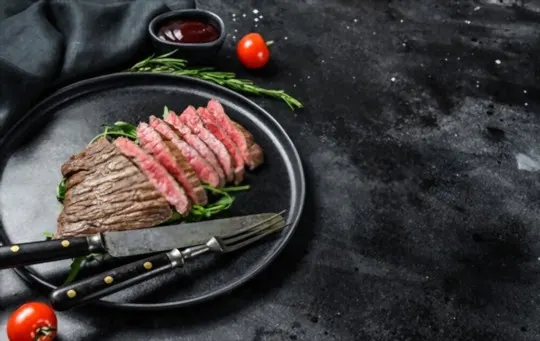
Flat Iron Steak vs Flank Steak: Which is a Better Option?
Ingredients
- Flat Iron Steak
- Flank Steak
Instructions
- Choose between two items based on your preference and availability.
- Follow the cooking directions for your chosen option, using the appropriate ratio of ingredients.
- Prepare it according to your desired recipes.
- Incorporate them into your dish, adjusting the amount to suit your taste.
- Enjoy the unique taste experience and experiment with different dishes to explore their versatility.

Andrew Gray is a seasoned food writer and blogger with a wealth of experience in the restaurant and catering industries. With a passion for all things delicious, Andrew has honed his culinary expertise through his work as a personal chef and caterer.
His love for food led him to venture into food writing, where he has contributed to various online publications, sharing his knowledge and insights on the culinary world. As the proud owner of AmericasRestaurant.com, Andrew covers a wide range of topics, including recipes, restaurant reviews, product recommendations, and culinary tips.
Through his website, he aims to inspire and educate fellow food enthusiasts, offering a comprehensive resource for all things food-related.
